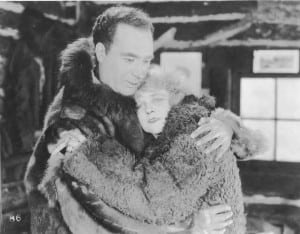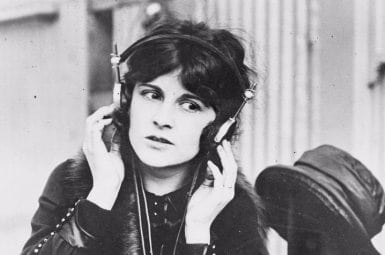By Steve Dunkelberger

The year was 1927. Hollywood didn’t exist. The now famous mountaintop sign in Southern California was only four years old and still read “HOLLYWOODLAND” to advertise the rise of an up-scale development. Cottage moviemakers were turning out silent movies nearby, but it was not the movie hub it is today.
Tacoma could have become the Hollywood we know. It was, after all, once home to one of the largest movie studios in the nation. Only Metro Goldwyn Mayer Studios had a larger film lot. Tacoma’s H.C. Weaver Productions was located on land that is now Titlow Beach.
“There was no other studio like this outside of California,” Tacoma historian and architectural preservationist Michael Sullivan said.
All but a few bungalows used to house actors remain. Even the three films shot by the studio were feared lost — until now. The story of the studio, its films and recent discovery of one of them is the making of a movie script itself.
H.C. Weaver Productions of Tacoma opened its doors in 1924 on a site selected for its rustic woods and scenic views that would be used in future films. Those films would star some of the most popular actors of the era. The high point of the studio was the filming of “The Eyes of the Totem” in 1927, which followed the studio’s nationally released “Hearts and Fists” and “The Heart of the Yukon.”
“Totem” capped those previous releases in popularity. The film was directed by Woodbridge “One-Take Woody” Van Dyke. The 35-minute melodrama has Mariam Hardy (played by Wanda Hawley) persuading her husband (Monte Wax) to sell his lucrative land claim in Alaska and return to civilization for the sake of her daughter Betty (Anne Cornwall). A stranger then mysteriously kills the husband and escapes with his cash. The mother and daughter then find themselves walking penniless on the streets of Tacoma, even being saved by a blind beggar from being hit by a horse cart, according to The American Film Institute Catalog of Motion Pictures 1921 – 1930. The beggar (Bert Woodruff) then convinces Mariam to pretend she is also blind to beg for spare change and wait under the landmark totem pole for the sight of her husband’s killer. She gains enough money to send her daughter to a boarding school while she bides her time. Years pass. Mariam finally recognizes a café owner named Philip LaRue (Tom Santschi) as the murderer and sets out to catch him. Meanwhile Betty and her boyfriend have a chance encounter with the café owner and unknowingly plan to have tea with him. Police swoop in and save the day. LaRue dies dramatically, and Mariam reunites with her daughter as the screen fades to black.

Everyone associated with the film was either a star or a rising starlet. Hawley, for example, was a popular leading lady of the silent era who specialized in sweet romantic comedies and romantic dramas. She rose to stardom in Cecil B. DeMille films and later starred in films for director Sam Wood. Cornwall was starting her career when she played the role of Betty in “Totem” but would go on to star in “College,” alongside Buster Keaton in “Men O’ War,” with Laurel and Hardy.
Woodruff had bridged the world of touring vaudeville troupes to film acting to become a leading man of his time. He entered pictures in 1916 with D. W. Griffith, appearing in “Jim Bludson,” “Veteran Sinners,” “Children of Dust,” “Flaming Gold,” “The Barrier,” “The Fire Brigade,” “Spring Fever,” “Speedy,” “Masked Money” and “The Awakening.” He appeared in nine Charles Ray films and in “Song of Kentucky” in 1929. He also had directing and writing credits during his career.
“The Eyes of the Totem” was a big film and was priming Weaver Studios to bigger things. Then fate stepped in. Weaver Studios closed a year after its release, falling victim to the rise of “talkies” and the consolidation of film studios that squeezed out smaller film-making houses.
The Weaver studio complex all but disappeared. The films were lost to history; only a few promotional photos and posters were known to exist. Fate stepped in again. The late Tacoma historian and author Murray Morgan would often talk about “Eyes of the Totem” during his now legendary presentations about the bygone days of the City of Destiny. The film had gained almost mythical status as historians and researchers spent decades looking for copies or even short clips to screen for historical research. Nothing was found.
Fast forward eight decades.

Tacoma’s Historic Preservation Coordinator Lauren Hoogkamer was researching Tacoma’s historic totem, which was undergoing restoration, when she heard tales of a lost film that was made in Tacoma. A few calls and some luck led her to find the full five reels of “The Eyes of the Totem” were in storage at the Museum of Modern Art in New York City. The museum had the aging nitrate film on a list of 25,000 movies set to be restored as time and money permitted.
“MOMA restoration process is the best in the world,” Sullivan said. “They have a world-class collection.”
A blizzard of calls and emails followed. Sullivan talked to Tacoma Art Museum Director Stephanie Stebich about the restoration effort. Fate had it that she just happened to know Glenn Lowry, the director of MOMA, and asked him if he could boost the film higher up on the restoration priority list.
The film restoration would be fast tracked only if Tacoma historians funded the effort. Challenge accepted. A Kickstarter campaign is now coming to a close to fund the $25,000 restoration bill that includes commissioning a new score by local composer John Bayman to add sound to the silent movie, gaining the rights to screen the film and promoting Tacoma history with replica posters and t-shirts. A donor-only screening of the film is scheduled for September 18 at the Rialto. Future screenings and documentary projects are also in the works.
But for now, Tacomans are preparing to see not only an 88-year-old film that was produced in the City of Destiny but view scenes of the city itself, since the film includes street scenes of downtown Tacoma, the Winthrop Hotel, Annie Wright School, Union Station, Mount Rainier, historic Thornewood Castle and various landmarks around Pierce County as they existed in 1927. The namesake Totem still exists, now sitting at Fireman’s Park, and it can be seen several times in the film.

“The print is pristine,” Sullivan said. “We had hoped that a restoration would be able to save a few scenes and show a few landmarks, but here we have the whole film and it is in great condition. It is so clear you can read posters that are in the window across the street. It is remarkable.”
The film’s discovery and restoration has sparked a search for other relics of Tacoma’s film history and has provided inspiration to its resurging movie industry through the 253 Film Collective and Tacoma Filmmakers and the rise of The Grand Cinema’s Tacoma Film Festival.
An even higher-resolution version of the film is also in the works that will end with a copy of “The Eyes of the Totem” that is almost identical to the original.
“By the time we get that done, you will be able to read license plates,” Sullivan said.

































